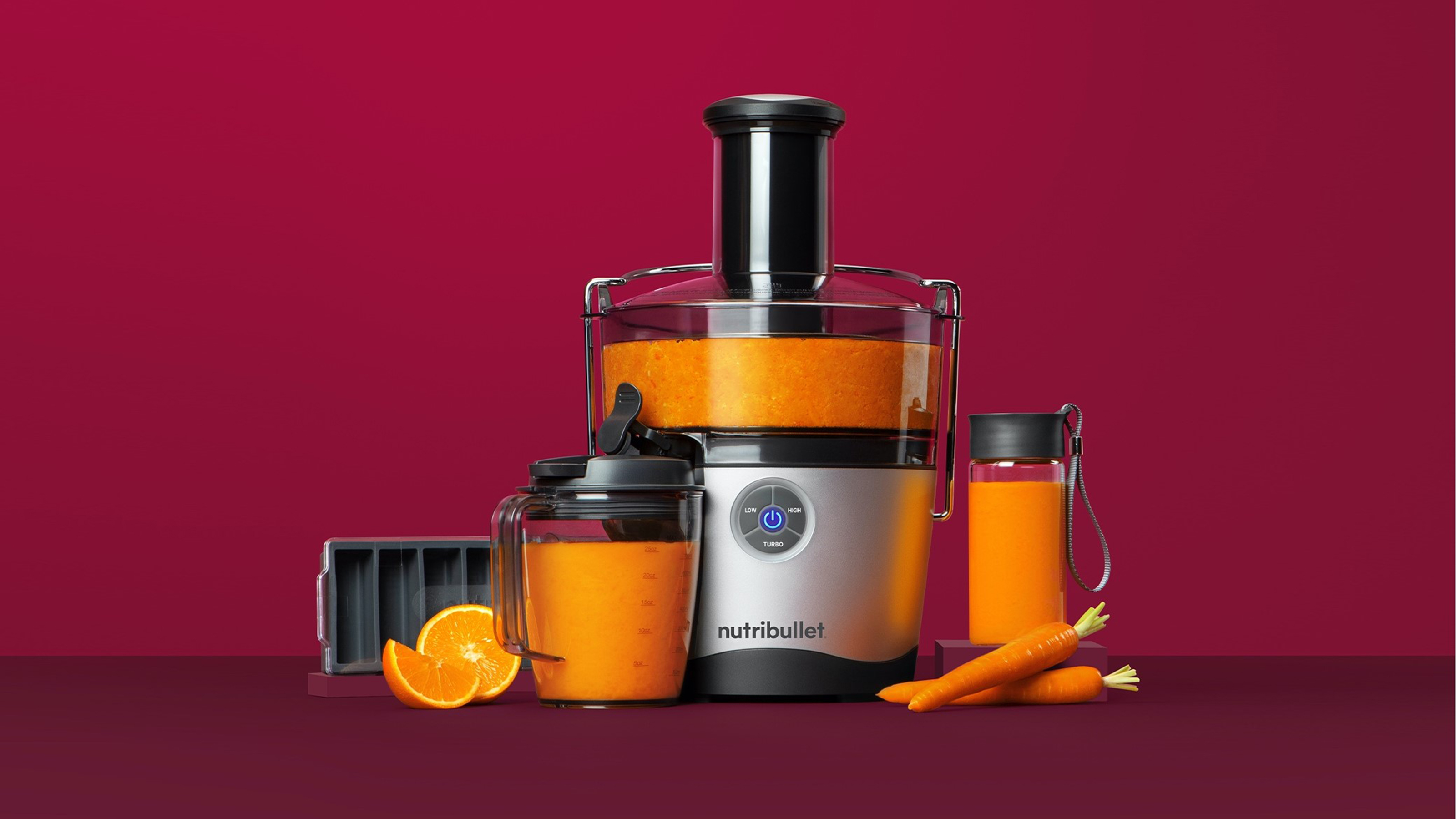
You might know Nutribullet for its single-serve blenders and smoothie makers, but it’s a brand well worth considering if you’re looking for a juicer. Specifically an orange juicer, actually. I've been using the Nutribullet Juicer Pro, which is an upgraded version of the more basic Nutribullet Juicer (with a few extras included in the box), for a good few weeks now and it's safe to say I am obsessed. Gone are the days of wasting money on cartons of orange juice or bottles of apple juice now that I have this countertop gadget. The fact it takes up a small amount of space in my kitchen is an added bonus.
It's quite reasonably priced in my eyes at $159.99/£299.99 and it can do more than just squeeze the goodness out of your oranges. Now, I tested the UK version which is the same as the US model apart from that it comes with just one to-go cup and one freezer tray, whereas the US model comes with two of each.
The Nutribullet Juicer Pro is a centrifugal juicer, so it extracts the juice using a fast-spinning grater and sieve. This type of juicer has a reputation for being less efficient than the more expensive cold-press variety. However, it's safe to say it surprised me with its excellent performance.
I put it to the test in my home and enjoyed making fruit as well as vegetable juices in this simple juicer. You’ve probably already guessed that I think it’s a good buy, but it’s worth scrolling down for more insight into its good and bad points as well as my thoughts on all the accessories — not to mention just how easy and convenient it is to clean.
TLDR: What we thought of the Nutribullet Juicer Pro
The Nutribullet Pro is a great all-around juicer, whether you want something for just making orange juice on the weekend, or if you're after something to use every morning to get your five a day in early (without fail). It's a do-it-all machine that's simple to use really since it has only three speeds. It also comes with everything you need to use it included in the box. It's great for smaller kitchens as it has a small footprint, and it's easy to store away under your countertop if you (understandably) don't want it on display. I used it to make orange, apple, and vegetable juice, and every time it was simple and always easy to keep clean. The only thing is that it needs to be dissembled so you can remove the pulp from the machine. This shouldn't be an issue with daily use but might get annoying if you're juicing a lot of fruit and veggies at one time.
Testing the Nutribullet Juicer Pro
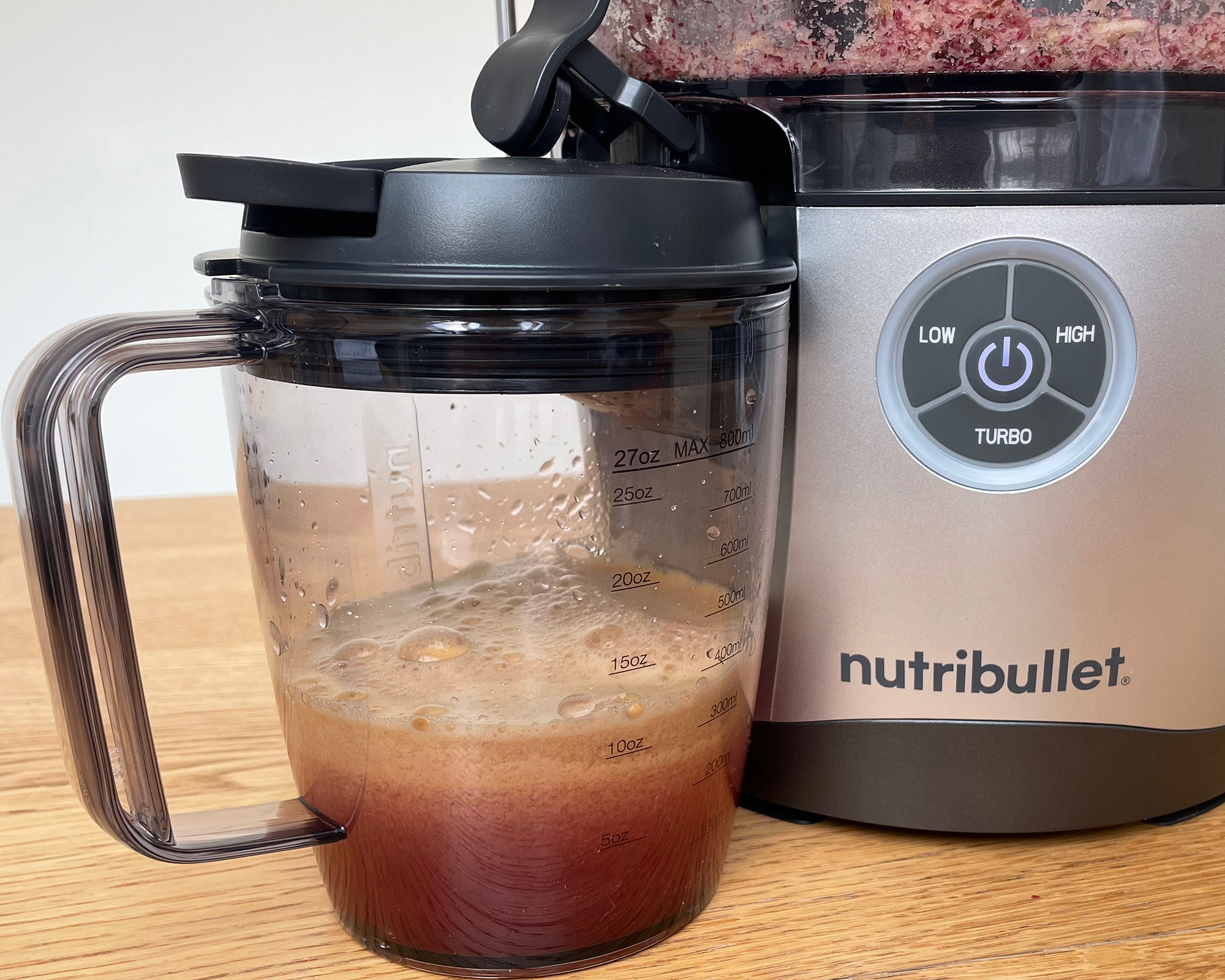
Freshly-pressed apple juice made using Nutribullet Pro

Helen has been reviewing kitchen appliances for over 10 years and has reviewed many juicers during that time for a variety of different publications. She has tested five juicers for us in total, from the likes of Nutribullet, Philips, and more popular brands, but this one has undoubtedly been her favorite hence the five-star rating.
Her favorite juice currently is a mixed juice that contains some lower-sugar ingredients such as leafy greens and ginger for a punchy flavor.
The techy stuff
• Centrifugal or masticating: Centrifugal
• Material: Plastic
• Capacity: 800 ml/ 27 oz juice pitcher with lid and froth separator. 2,000 ml/ 75 oz pulp container
• Feeding tube: 76 mm/ 3 in
• Power: 1,000 watts
• Weight: 7.5 lbs
• Dishwasher safe: All parts except the food pusher
• Other features: Three speed settings, dual size pusher
• US model supplied with: Two 11-oz glass to-go bottles, 4-oz freezer tray, 2-oz freezer tray, and cleaning brush
• UK model supplied with: 340 ml glass to-go bottle, 118 ml freezer tray, and cleaning brush
• RRP: $159.99/£299.99
Unboxing the Nutribullet Juicer Pro
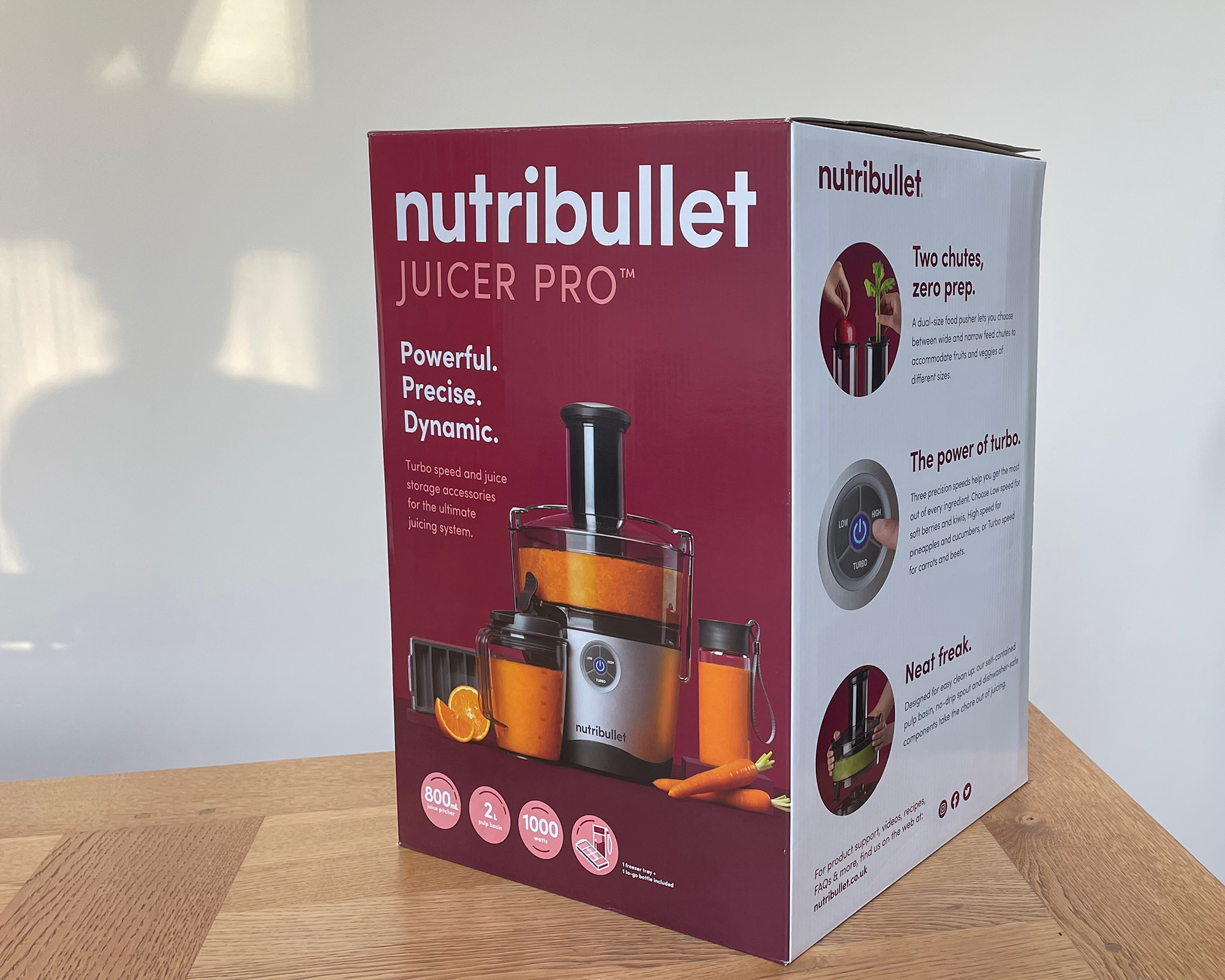
Nutribullet Juicer Pro in box
The Nutribullet Juicer Pro comes out of the box pretty much assembled and ready to go.
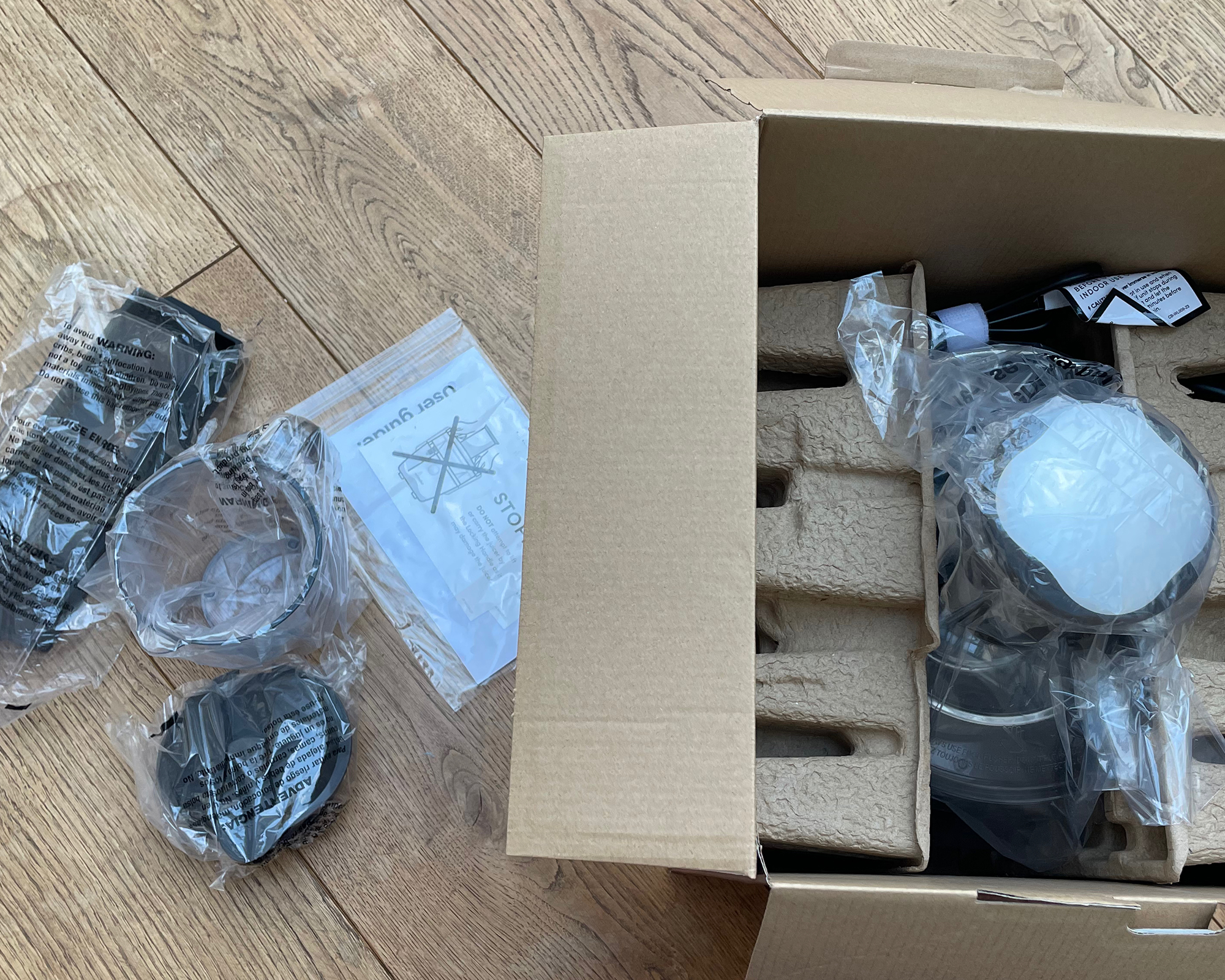
Inside of Nutribullet Pro Juicer packaging
The parts are wrapped in plastic bags, but because the bulk of the packaging is cardboard that can go straight into my recycling, it got off to a good start.
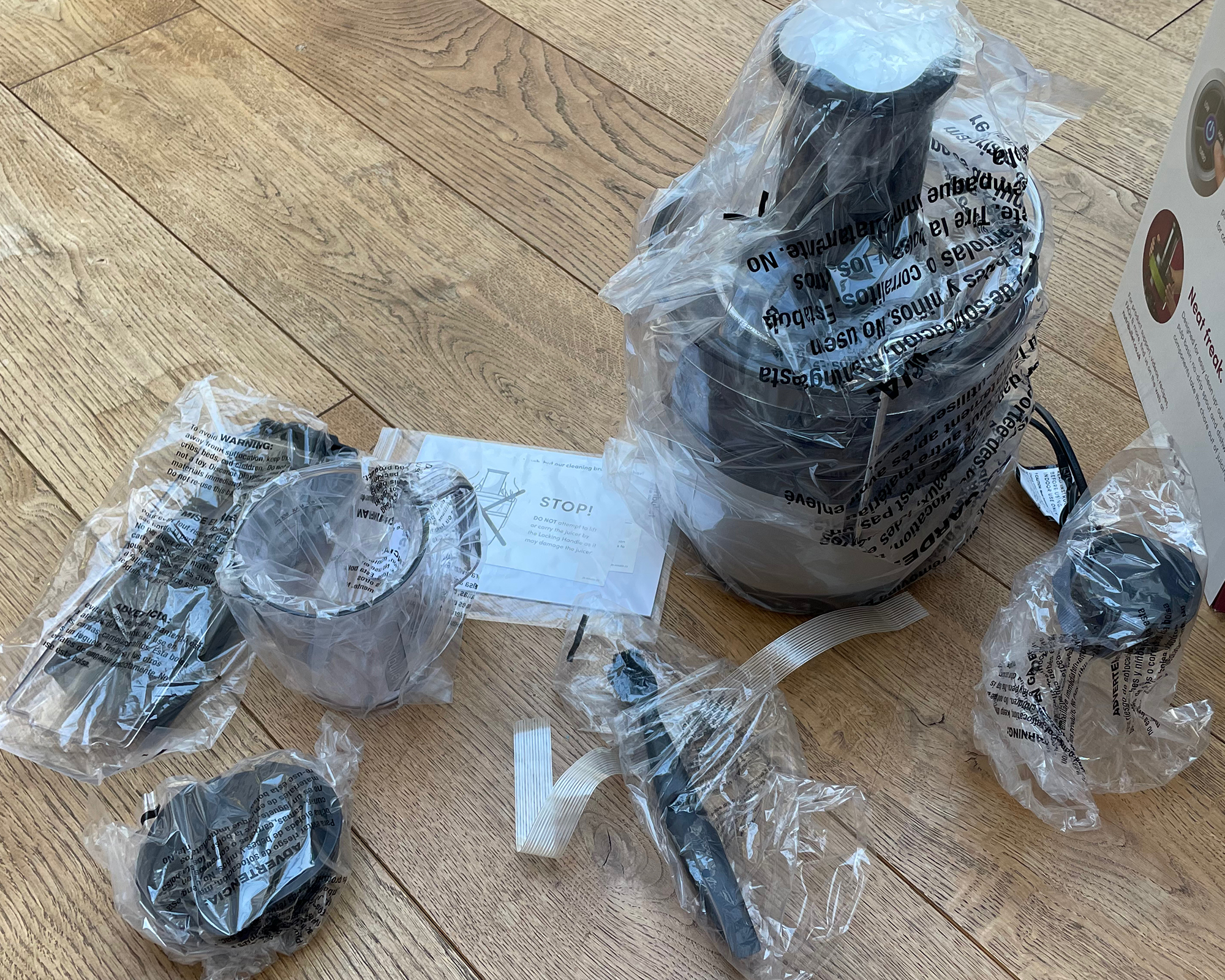
Unboxing the Nutribullet Pro in plastic wrapping
Size-wise, the juicer is bulky towards the top, but it’s narrower at the base so that it doesn’t take up too much counter space, which I like. Given the very reasonable price tag, all the parts felt sturdy and well-made. And because it comes fully assembled, you don’t have to spend hours figuring out which part goes where. Though even if you did, it wouldn’t take long. The set-up is simple even if you’re new to juicers. With a clear manual that includes plenty of illustrations, there’s enough guidance to help out even the most gadget-opposed person.
Immediately, I noticed that there isn’t the usual pulp container, and that’s when I discovered that the pulp collects inside the main juicing mechanism. On one hand, this is a good idea because it keeps the whole machine neater and means there are fewer containers and parts sitting on the counter. On the other hand, it means if I decide to juice a big batch, it’ll need to be disassembled when the pulp container needs emptying.
Likewise, the juice pitcher isn’t huge — it can only hold enough for a couple of glasses of juice. So I’d say this isn’t an appliance that’s designed for making juice in bulk.
How to use the Nutribullet Juicer Pro
On the front of the body, the settings are straightforward, just three clearly labeled speed buttons surround the on/off button. The manual includes a comprehensive list of 28 fruits and vegetables, detailing which speed you should use for each. This combination of simple settings combined with the info in the manual is enough to give most people the confidence to get juicing straight away.
I also love the to-go cup. For some people, it might be a bit on the small side, but for me personally, it’s about the right size for a glass of juice. It's actually glass as opposed to cheap flimsy plastic, which is a welcome detail.
The silicone freezer tray comes with a lid and it too feels well-made. There certainly seems to have been plenty of thought put into this relatively budget appliance which surprised me. For example, the juice pitcher has a lid for storing juice in the fridge, and it also has a built-in froth separator. I know from experience that centrifugal juicers produce frothier juice, and I like that Nutribullet is recognizing this and providing a simple solution.
Similarly, the dual-size food pusher is a simple but very useful design feature. It blocks part of the chute while you add small ingredients, which reduces the risk of bits flying back out. The spout can also be closed to stop juice from dripping onto the counter.
Making apple juice
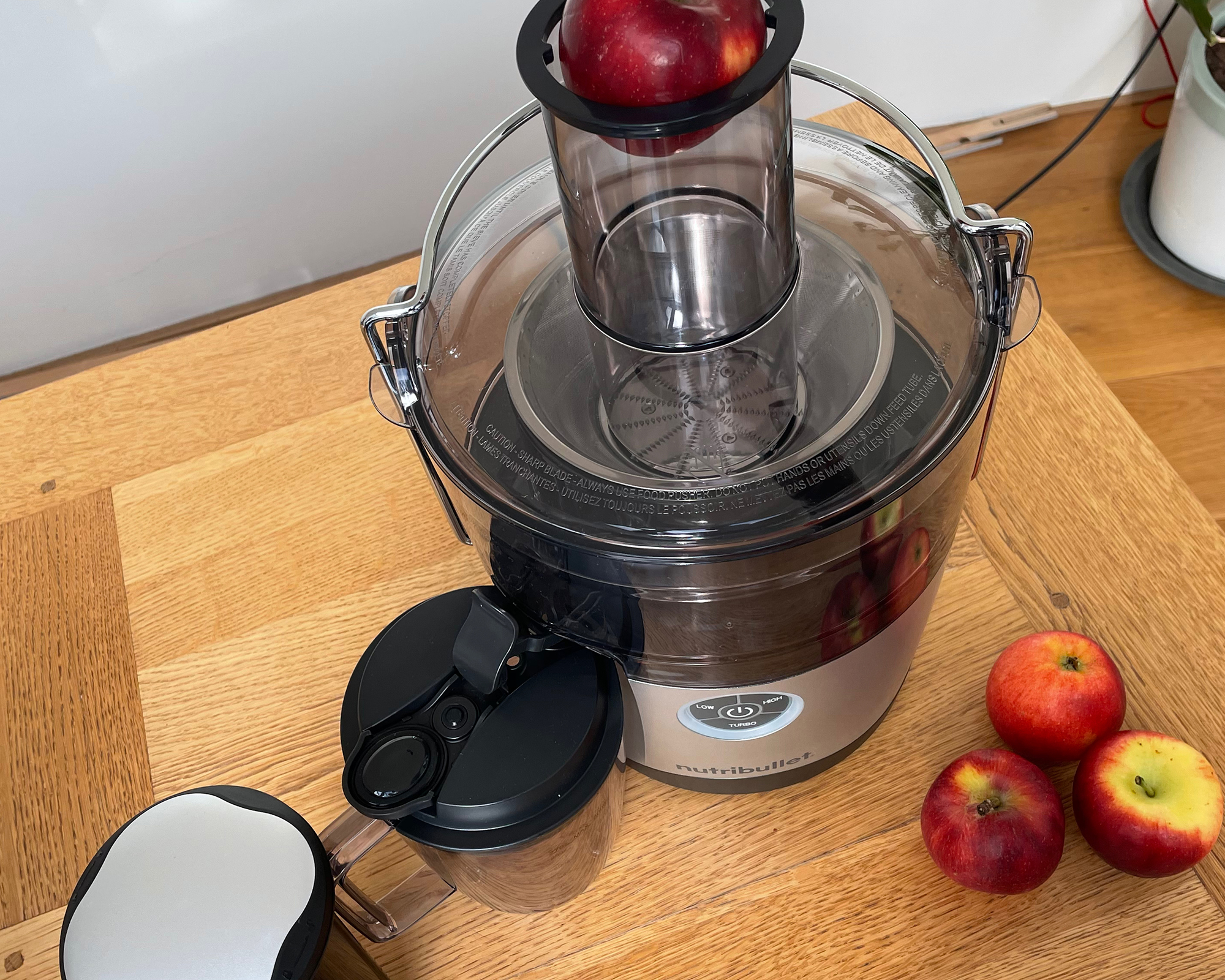
Nutribullet Pro juicing apples
I love to start with apples. It’s a great fruit to use when using a juicer for the first time. My apples were pretty small and they fit easily into the feed chute without being chopped, so happily there was no prep to do. The manual recommends the turbo speed for apples, so that’s what I used. I had to insert the pusher after each apple, to ensure they got properly juiced, but it was a speedy process nevertheless.
It got through all four apples in around 30 seconds, but it was quite loud and maxed out my noise meter at 84 dB, which is as loud as a blender. The juice had a layer of froth on top, but thanks to the froth separator only a small amount made its way into my glass.
I weighed the apples before juicing, and I also weighed the juice produced so that I could determine the percentage yield which was an impressive 74%. That’s as good as I’ve seen even from a high-yield slow juicer and far better than many centrifugal juicers.

Freshly-pressed apple juice made using Nutribullet Pro
The juice itself was deliciously sweet, though the texture was somewhat powdery. Evidently, lots of very tiny pieces of apple fibers had made their way into the drink. This didn’t really bother me, but it’s a case of personal preference. If you’re looking for super clear juice, it may not be to your liking.
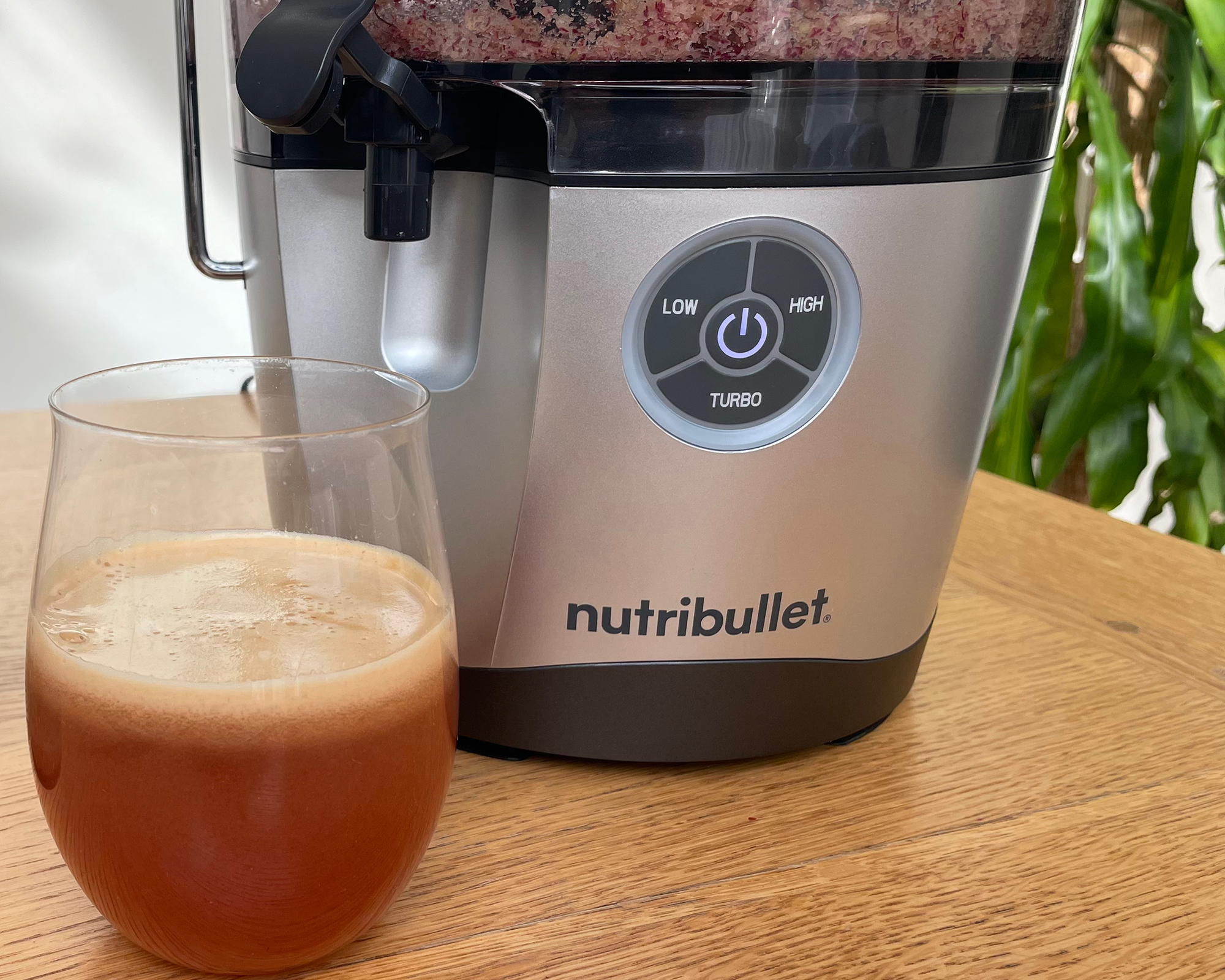
A glass of freshly-pressed apple juice
Making orange juice
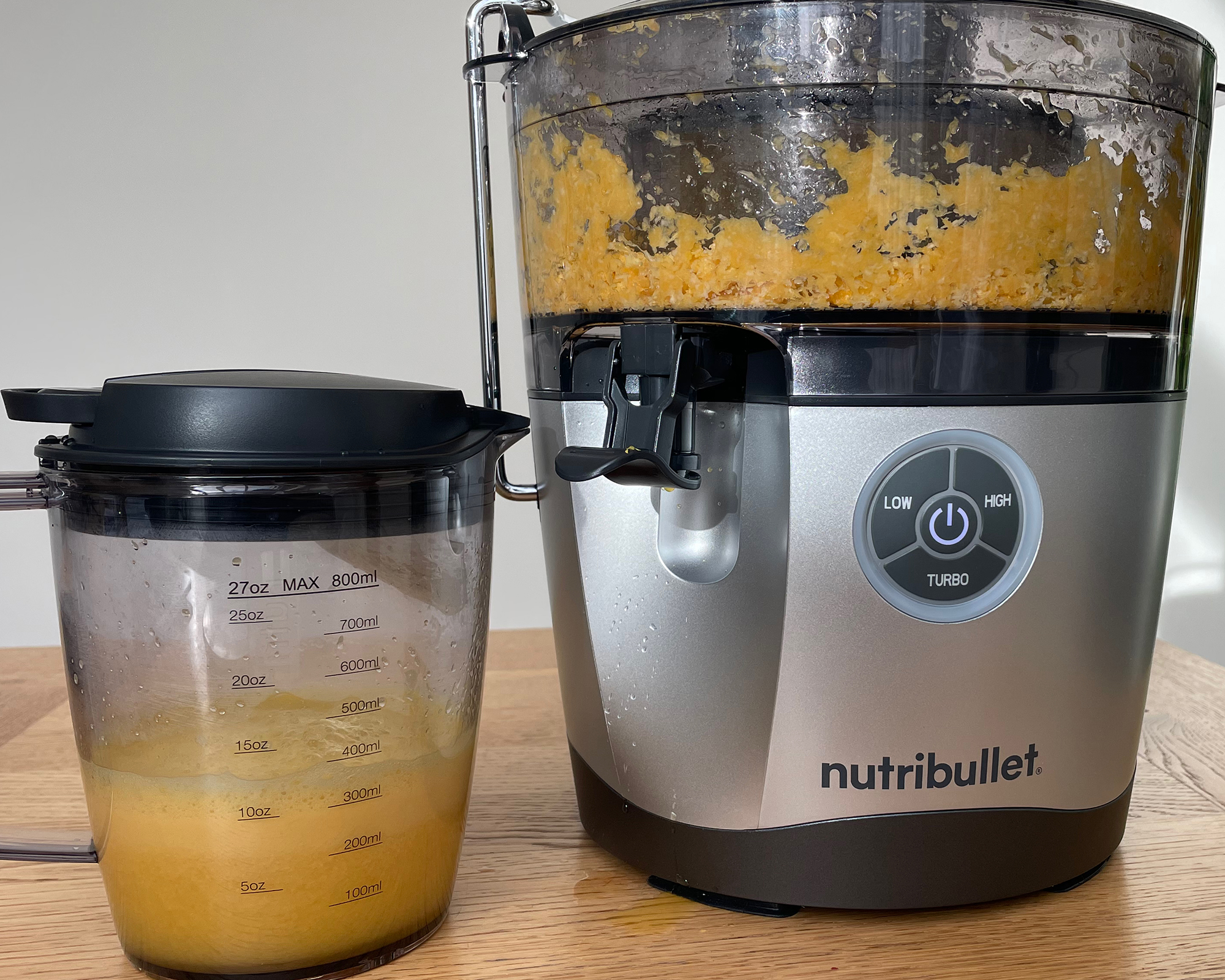
Preparing fresh orange juice in the Nutribullet Pro
I found it odd that the manual suggests the turbo speed for oranges, yet low speed for lemons and limes. Regardless, I followed the suggestion and switched it on to turbo before popping my whole peeled oranges in.
I followed with the same process I used for the apples, inserting the pusher after each orange and it juiced four in a speedy 20 seconds. It was a little quieter this time at around 78 dB, which is closer to the noise a vacuum makes. The juice was a little pulpy and quite aerated despite the froth separator skimming off the worst of the froth. The juice yield was a respectable 64%, which again, is pretty good for a centrifugal juicer.
Making a vegetable juice
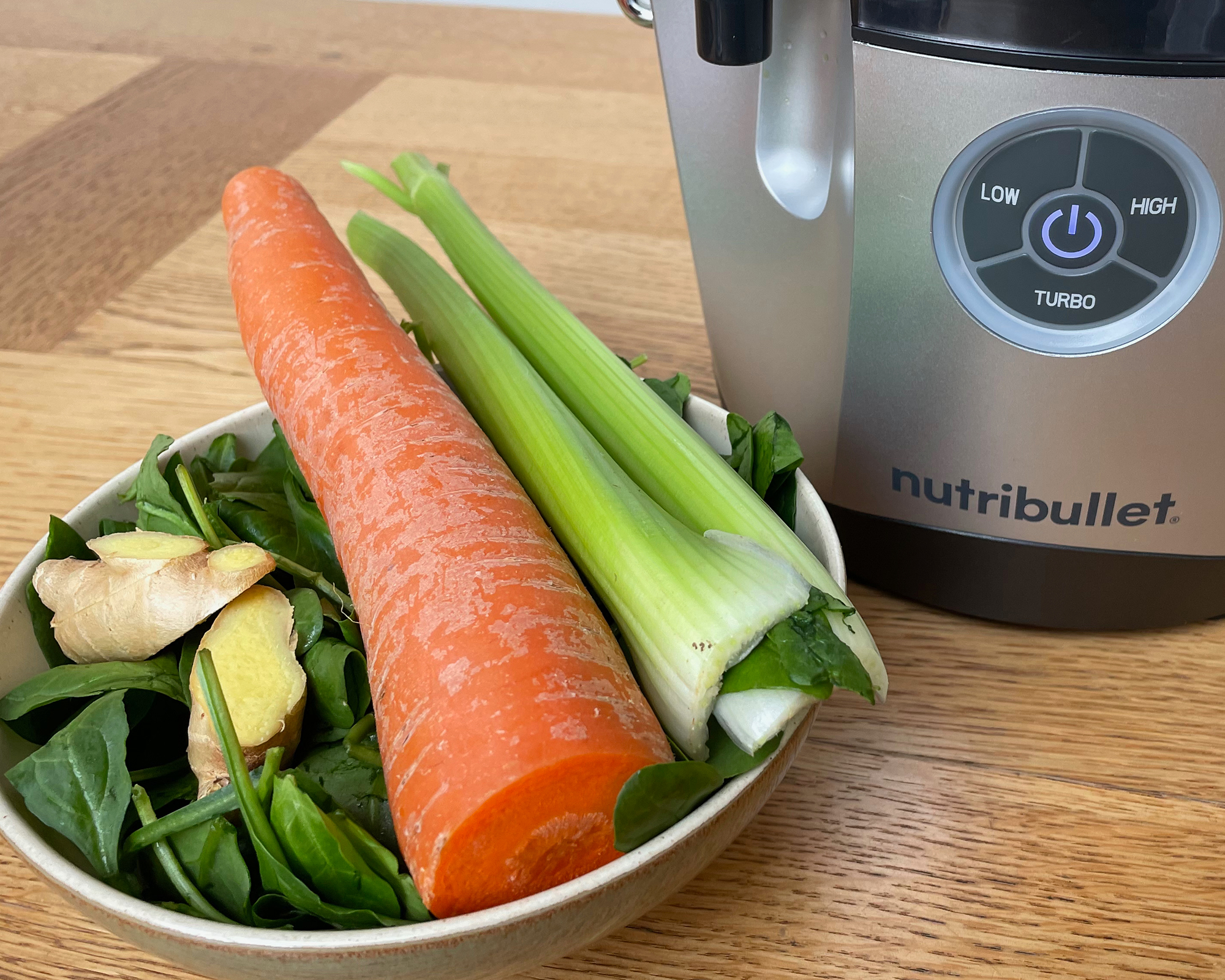
Nutribullet Pro making vegetable juice with ingredients
To see how well it copes with a combination of different vegetables, I made a mixed juice of celery, carrot, spinach, and ginger. The manual recommends turbo for all these vegetables apart from spinach, which should be done at low speed. So I started with the spinach and then turned up the speed for the rest.
This time I used the narrow pusher and left the celery and carrot whole. It took almost a minute and a half, not because the juicer was slow, but because the spinach in the narrow chute kept causing the pusher to get stuck and I had to work to free it.
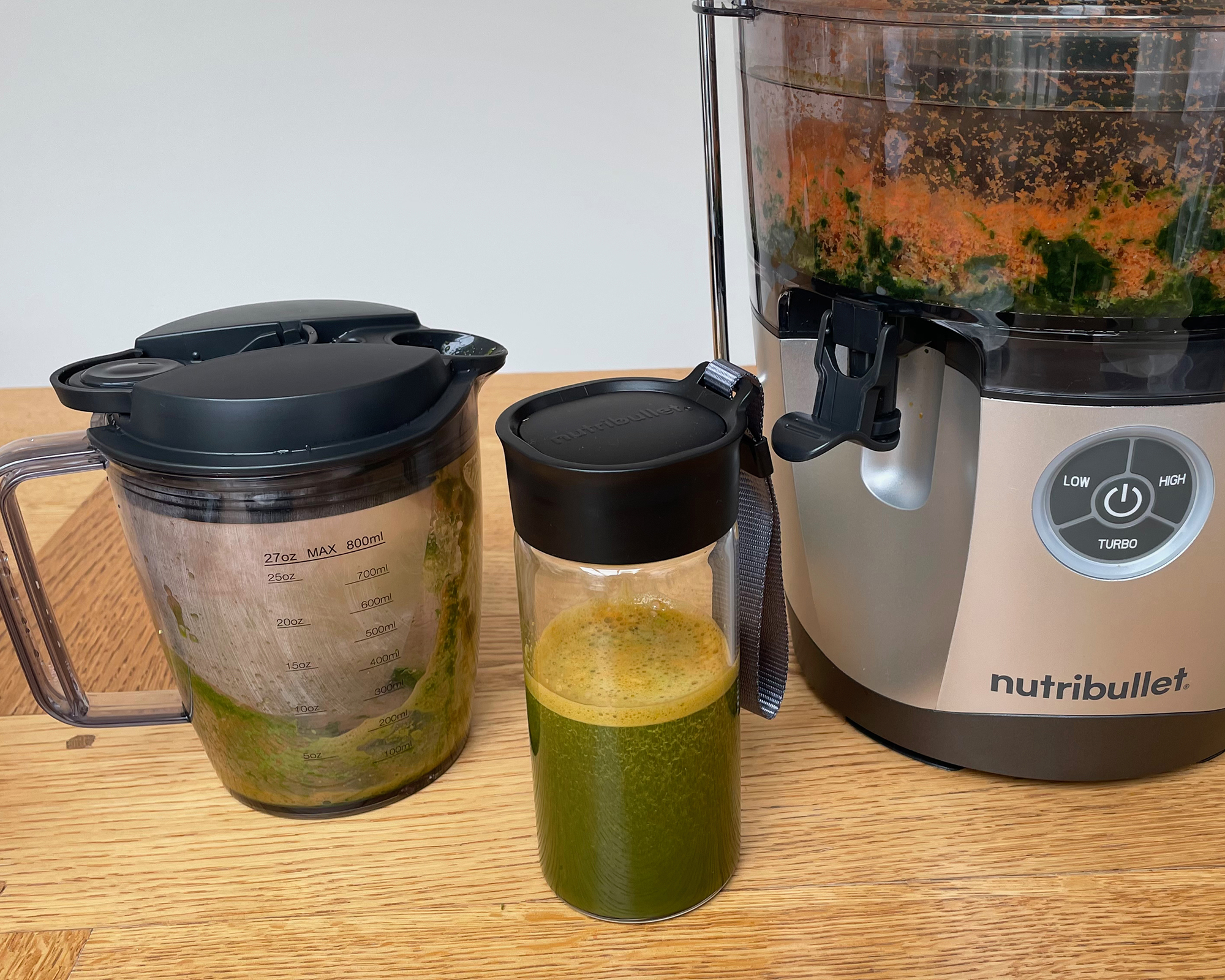
Making vegetable juice in the Nutribullet Pro
The juice had a pulpy texture, which I think is good when you’re opting for a healthy juice because the pulp makes it feel a bit more virtuous. It wasn’t too bitter and had a fiery ginger kick. The yield is around 52%, which is as good as many of the more expensive juicers. Though I suspect the high yield is in part due to the fact you’re getting some of the pulp too. I poured this juice into the to-go cup. I found it was great quality and nice to drink from.
Juicing raspberries
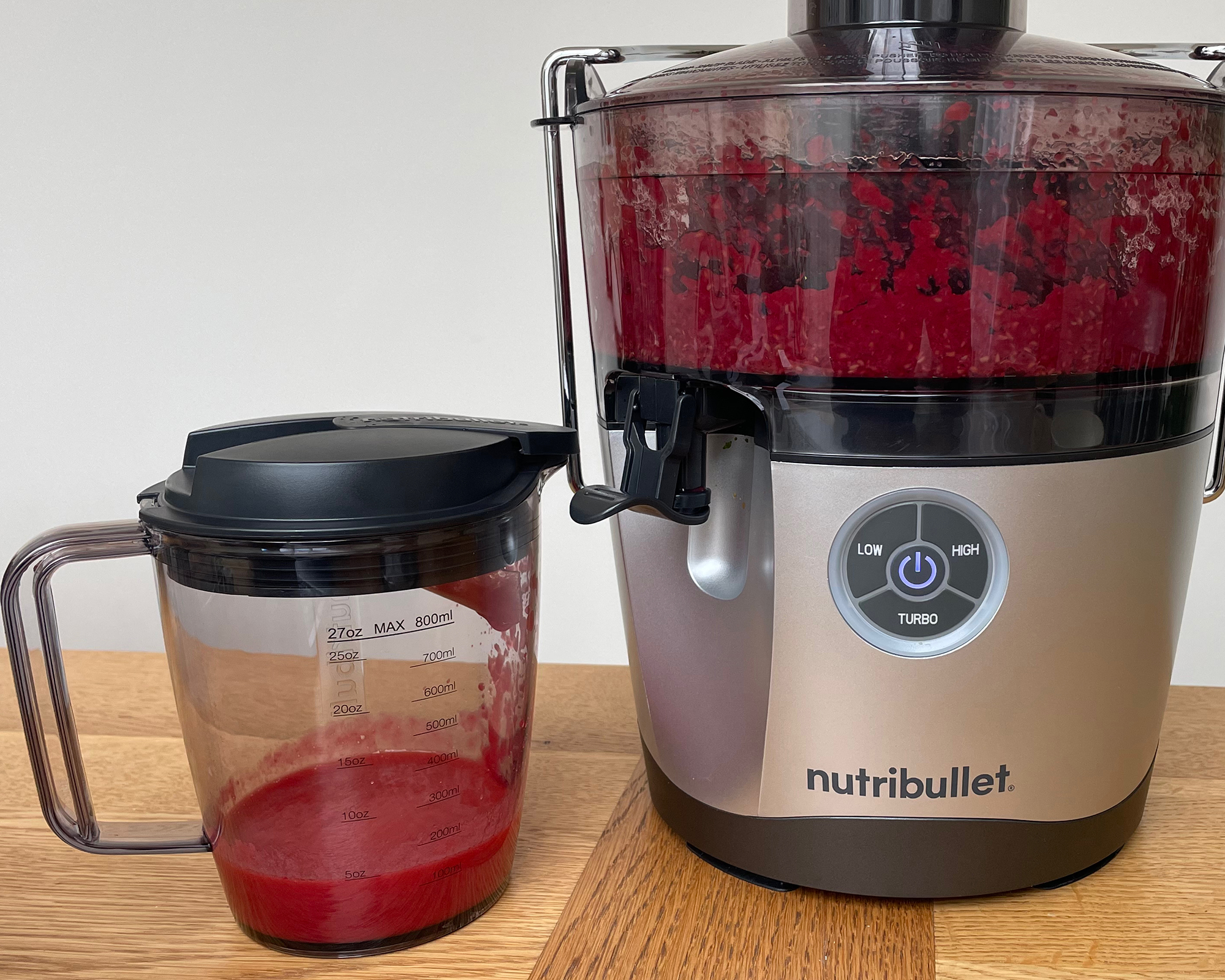
Making fresh raspberry juice in the Nutribullet Pro
I used the lowest speed for raspberries as suggested in the manual. It managed to juice my 10.5-ounce pack in around 30 seconds, creating a thick smooth raspberry puree. The yield was 42%, which does mean there’s a lot of waste but having said that it’s the second-best yield for raspberry juice out of the four juicers I’m currently reviewing. That's not bad for the cheapest juicer!
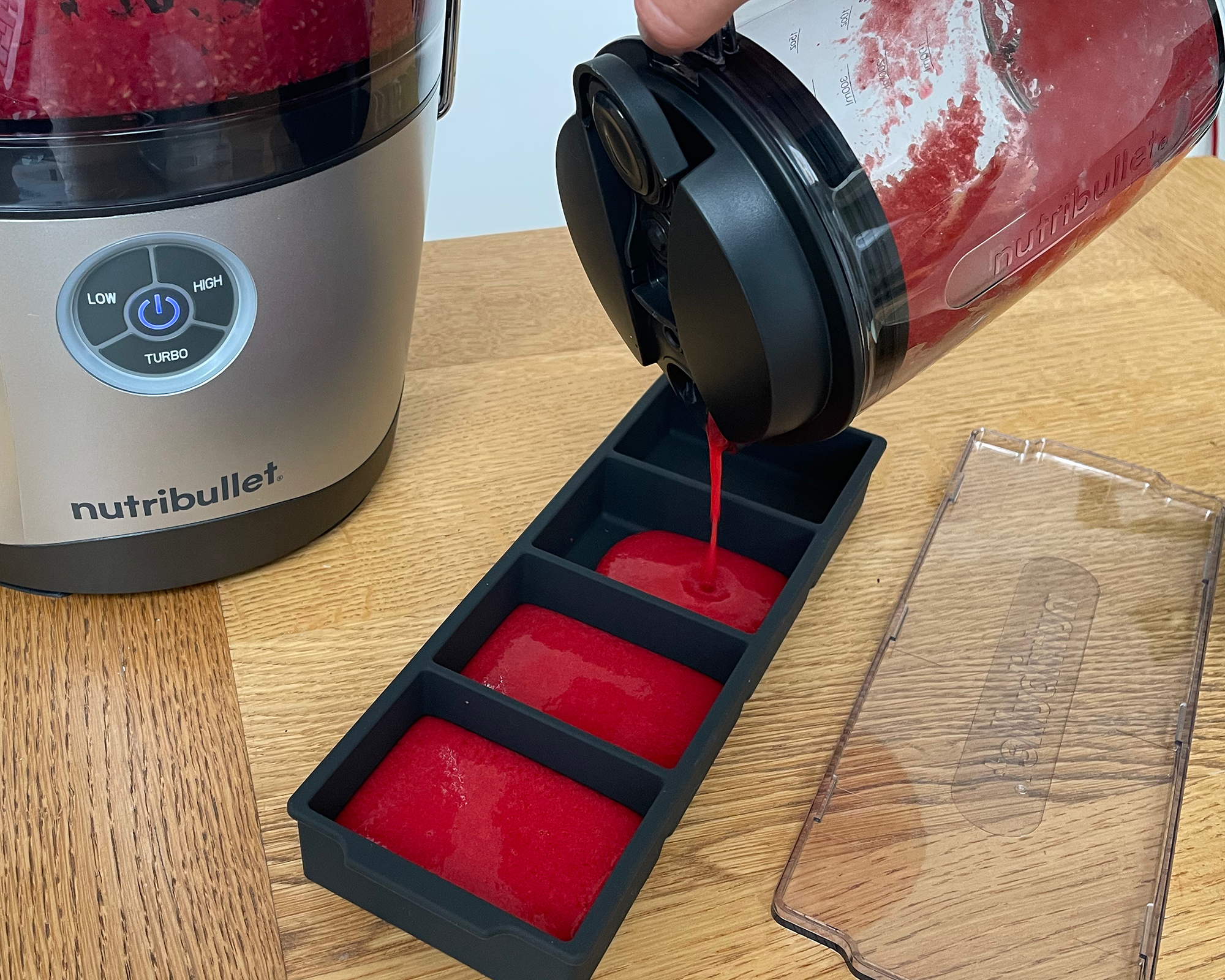
Decanting fresh raspberry juice made in Nutribullet Pro
I made use of the ice tray to freeze the raspberry puree for another day. It’s silicone, so the frozen cubes were easy to pop out. The tray can also go in the dishwasher.
Cleaning the Nutribullet Juicer Pro
Removing the pulp is a bit of a pain — unlike most other juicers that eject the waste into a container on the outside, this one keeps it all locked inside, so it can only be emptied by disassembling everything. Most of the time this isn’t too much drama, but if you're planning on juicing your way through a bulk box of fruit, it could become annoying.
Everything — apart from the base and the pusher — is dishwasher safe, so if you have a dishwasher, it’s easy to clean. That being said, I found it took up a lot of space inside my dishwasher, so I opted to clean it by hand several times. (This wasn’t too tricky.) Plus, my dishwasher didn’t fully remove all the fibers from within the fine mesh of the sieve, and I found this was best cleaned with the supplied brush even if I was planning to pop it in the dishwasher.
How does the Nutribullet Juicer Pro compare to other juicers on the market?
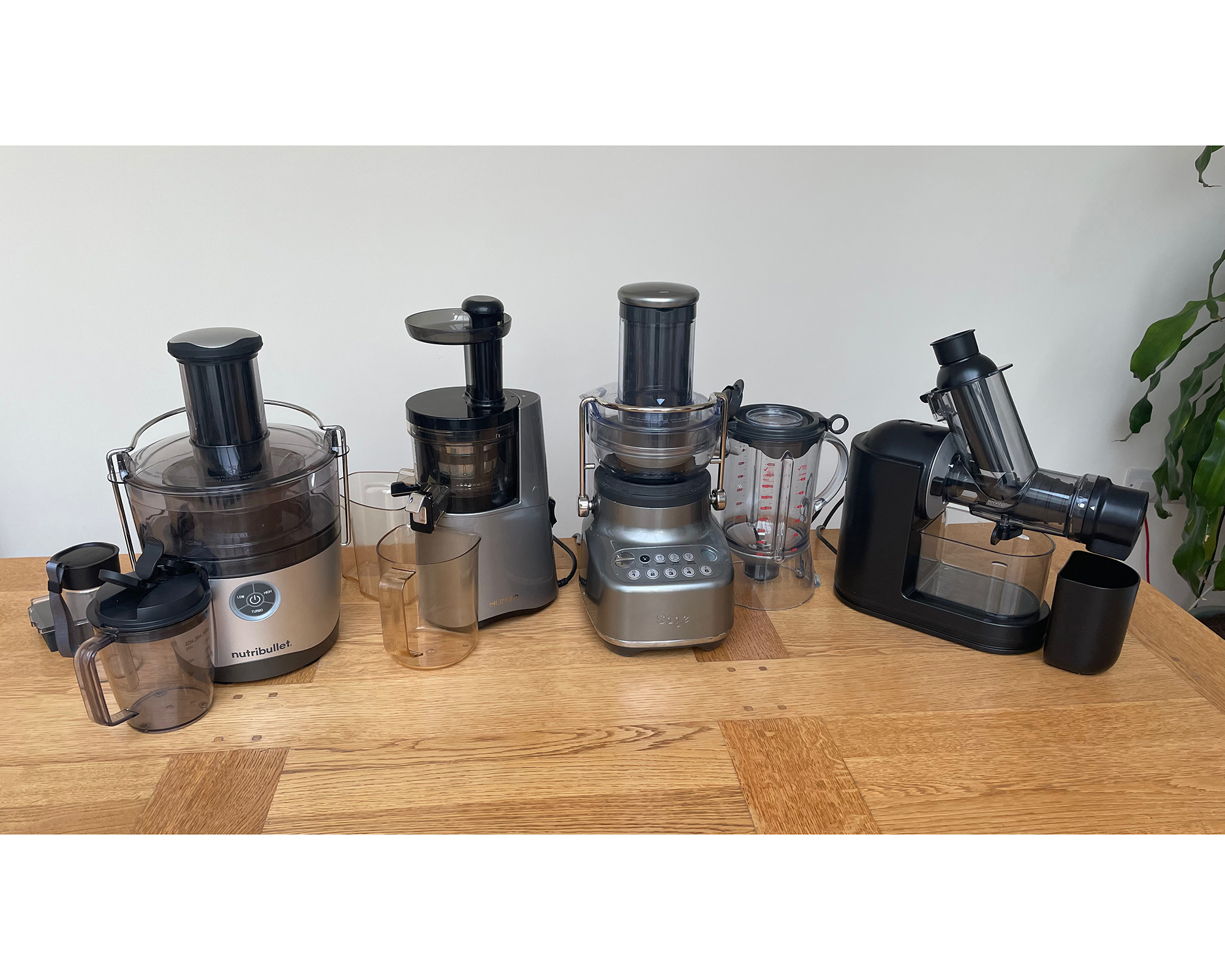
A selection of juicers
The Philips Viva Masticating Slow Juicer is a UK-only model but at just over £100 it’s a slow juicer for similar money. In general, it produces much lower juice yields, but the juice is much smoother with less froth. So it’s worth considering if you’re particular about the texture of your juice.
If you’ve got a bigger budget, you could consider the Hurom H-AA which is a high-end slow juicer that’ll set you back $440/£389. It’s a capable high-yield juicer that’s compact on the counter. Its parts are not dishwasher safe and the small chute means most fruits and vegetables need chopping up before juicing, so there’s more work involved.
Should you buy the Nutribullet Juicer Pro?
If you’re just beginning your juice journey, this is an excellent model to get started with. It’s easy to use and not too expensive. It also does everything you need it to, so you really can’t go wrong with this juicer. Though it doesn’t create super smooth froth-free juice, for a centrifugal juicer, the juice yields are really very good. In fact, I'd say the only reason not to buy it would be if you’re worried about the potential loss of nutrients that can occur when using a centrifugal juicer, in which case a cold press masticating juicer will be a better choice.
About this review and our reviewer
After completing a home economics degree, Helen went on to work for the Good Housekeeping Institute and has been reviewing home appliances ever since. She lives in a small village in Buckinghamshire in the UK and was allowed to keep this Nutribullet Juicer after the review.
Helen reviewed this juicer alongside three others for Real Homes, so she could make informed comparisons on the speed of juicing as well as juice yields and ease of use. She might have felt like she’d been on a juice cleanse by the end had she not been heavily supplementing all this juice with copious amounts of cheese and mashed potatoes.
Join our newsletter
Get small space home decor ideas, celeb inspiration, DIY tips and more, straight to your inbox!

Helen McCue is a freelance contributor who trained as a Home Economist. After starting her career in the food industry, she moved into home appliance reviews, utilising her cooking skills and experience to put all kinds of products to the test, and over the years has reviewed hundreds of home and kitchen appliances for a variety of publications.
-
 Jennifer Garner's dining room is filled with “cohesive and intentional” features that showcase her personality
Jennifer Garner's dining room is filled with “cohesive and intentional” features that showcase her personalityDesigners love how the actor's space is rustic yet refined
By Eve Smallman Published
-
 Bobby Berk has revealed his favorite wall paint color — designers agree that it's a chic choice
Bobby Berk has revealed his favorite wall paint color — designers agree that it's a chic choiceThe Queer Eye star's choice of black is elegant and easy to decorate with
By Eve Smallman Published
-
 Vanessa Hudgens’ wallpaper puts a trendy twist on a classic style — designers love her effortless approach
Vanessa Hudgens’ wallpaper puts a trendy twist on a classic style — designers love her effortless approachThe actor's nature-inspired print is characterful and chic
By Eve Smallman Published
